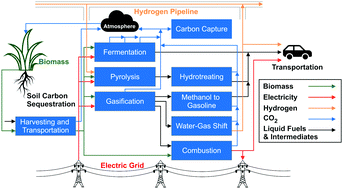Geissler, C.H. and Maravelias, C.T. (2022). “Analysis of alternative bioenergy with carbon capture strategies: present and future.” Energy & Environmental Science 5, 2679-2689. https://doi.org/10.1039/D2EE00625A [open access]
Abstract: Biomass can be converted via fermentation, pyrolysis, gasification, or combustion to a variety of bioenergies, and each conversion technology generates streams with different flows and CO2 concentrations that can undergo carbon capture. We use system-wide optimization models to determine the conversion technologies and level of carbon capture that lead to the minimum breakeven cost of fuel for a range of capacities and sequestration credits. We investigate how the optimal systems depend on constraints, such as energetic biorefinery self-sufficiency; and parameters, such as biomass availability. Pyrolysis to gasoline/diesel with hydrogen purchase produces liquid fuel for the lowest cost when energy purchase is allowed, with flue gas capture incentivized at sequestration credits of $48–54 per Mg CO2. With increasing sequestration credits, gasification to gasoline/diesel with carbon capture becomes optimal. When all bioenergies are considered, the cost per forward motion of electricity and hydrogen is lower than for liquid fuels because of the higher efficiency of electric motors and hydrogen fuel cells. We find that while gasification to electricity results in the greatest greenhouse gas mitigation under the current energy production mix, gasification to hydrogen is expected to result in the greatest mitigation in the future as the energy production mix changes.
Broader context: Bioenergy with carbon capture and sequestration (BECCS) is expected to be pivotal in global warming mitigation. BECCS systems include conversion technologies such as fermentation to ethanol, pyrolysis to gasoline/diesel, gasification to gasoline, combustion to electricity, and gasification to electricity or hydrogen. However, it is not yet clear which of these different conversion technologies with integrated carbon capture has the greatest economic and CO2 mitigation potential. Accordingly, we determine the cost-optimal BECCS strategy under a wide range of scenarios and assumptions. Looking into the future, we present the expected mitigation potential of the most promising BECCS strategies through 2050.

